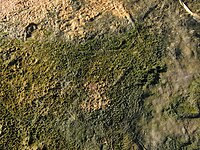
Photo from wikipedia
While water and sediment microbial communities exhibit pronounced spatio-temporal patterns in freshwater lakes, the underlying drivers are yet poorly understood. Here, we evaluated the importance of spatial and temporal variation… Click to show full abstract
While water and sediment microbial communities exhibit pronounced spatio-temporal patterns in freshwater lakes, the underlying drivers are yet poorly understood. Here, we evaluated the importance of spatial and temporal variation in abiotic environmental factors for bacterial and microeukaryotic community assembly and distance-decay relationships in water and sediment niches in Hongze Lake. By sampling across the whole lake during both Autumn and Spring sampling time points, we show that only bacterial sediment communities were governed by deterministic community assembly processes due to abiotic environmental drivers. Nevertheless, consistent distance-decay relationships were found with both bacterial and microeukaryotic communities, which were relatively stable with both sampling time points. Our results suggest that spatio-temporal variation in environmental factors was important in explaining mainly bacterial community assembly in the sediment, possibly due lesser disturbance. However, clear distance-decay patterns emerged also when the community assembly was stochastic. Together, these results suggest that abiotic environmental factors do not clearly drive the spatial structuring of lake microbial communities, highlighting the need to understand the role of other potential drivers, such as spatial heterogeneity and biotic species interactions.
Journal Title: Environmental microbiology
Year Published: 2023
Link to full text (if available)
Share on Social Media: Sign Up to like & get
recommendations!